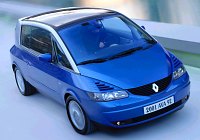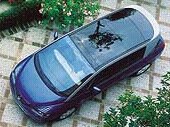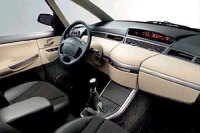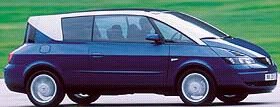 Undeniably,
the success of Renault in recent years is due to two reasons - cost
control
and MPV. The former must thanks to "le Cost Killer", vice-president
Carlos
Ghosn, whose work reflected most in the simplicity of production /
component
sourcing for Clio mk2 and Megane range. The MPV success must thanks to
its Undeniably,
the success of Renault in recent years is due to two reasons - cost
control
and MPV. The former must thanks to "le Cost Killer", vice-president
Carlos
Ghosn, whose work reflected most in the simplicity of production /
component
sourcing for Clio mk2 and Megane range. The MPV success must thanks to
its innovative designers and brave product planners ... and don’t miss Matra, who originated the concept of Espace and built it. While Espace was the first real MPV (unlike the people carrier Mitsubishi Space Wagon and van-like Chrysler Voyager), the Scenic spread the MPV love affair to smaller cars, then came the first off-road MPV, Scenic RX4. The newest trend setter is this one - Avantime, the first MPV coupe, or may I call it MPC (multi-purpose coupe) ? Calling it a coupe is somewhat misleading according to our normal definition of "coupe". The Avantime is based on the floorpan of Espace, having 4 individual seats, an MPV-style high center of gravity, a 1740 kg kerb weight and powered by a sedan V6. Don’t expect it to sprint to 60 mph in anything less than 8 and a half seconds and corner as if a normal car (let alone a coupe). The Avantime is still very Espace in nature, although it receives tauter suspension tuning and a six-speed manual gearbox. So why is it called coupe ? You won’t get the answer until looking it in detail. In my opinion, it is very stylish, even more beautiful than many coupes (e.g. Opel Astra coupe). While the front end might not be everyone’s taste, it is undeniably very distinctive and concept-car like. Grilles above the headlamps are deliberately added for visual effect - without them, the bonnet would have looked too high and less sporty. The most beautiful to look is from the sides - one big door each side (therefore coupe), big frameless windows, no B-pillar, two-tone colour with the aluminium pillars and roof rails exposed in original color, strong shoulder line, 17-inch wheels (another coupe feature), beautifully-shaped front quarter window .... The rear end looks even more unique, with a short and tilt tail (it actually has a hatchback open to the roof), wrap-around rear window and artistic rear lights. In short, the Avantime looks very advanced, very space-age. Only the French can do this.
The engine is the 3-litre V6 co-developed and produced with PSA. Like Peugeot 607, it has got 2-stage intake variable valve timing so that good for 210 hp and 210 lbft. That’s not very powerful for a 1740 kg vehicle. Originally Renault wanted to give it the 250 hp version from the mid-engined Clio Sport V6, but you know, the Avantime is front-wheel drive so that it is not easy to handle the extra power without torque steer. Anyway, the Clio’s 6-speed gearbox is employed to make better use of the less powerful V6.
The lack of B-pillar is compensated by the big doors which are designed to be part of the stressed structure when shut. This contributes to chassis rigidity and crash protection. The doors are extra large for rear passengers’ ease of access. Double hinges ensure you need not to swing it too wide to get in the front row. On the road Despite of imperfect fit and finish, the cabin has the sense of occasion unfound elsewhere, especially the 2-piece doors. There is abundance of room up front. At the rear, head and elbow room is also vast of, but leg room is just adequate for a regular height passenger. The biggest flaw is the lack of foot room under the front seats because the rear floor is higher than the front. Anyway, compare it with any coupes, it is still comfortably the most spacious.
The 305mm front Brembo discs provide sufficient stopping power to the 1740kg vehicle. Steering is quick and accurate, although communication is always not the strength of Renault. The 6-speed gearbox, as found in Clio V6 and Laguna diesel, is slick and playful. The big V6 is always linear and torquey enough at above 3,000rpm. All these sum up to an entertaining driving experience that no one would have predicted. To broaden its appeal, Renault also offers a cheaper version powered by a 2.0-litre 16V light-pressure twin-scroll turbo, with 165hp and plenty of low-end torque. Next year will come the 5-speed Tiptronic as already used in Laguna. However, I have no doubt that the V6 with 6-speed manual is the best combination. Renault and Matra
have again
rewritten the automotive history. As its name suggested, Avantime is
advancer
than the time being. It shows us how the future may be.
|
| The above report was last updated on 22 July 2001. All Rights Reserved. |
 Though
le Cost Killer is now in Japan heading Nissan, Renault won’t let the
style
of Avantime overriding the cost-cutting policy. In fact, although the
car
feels so unique, it is actually a low cost project needing just 60,000
to 80,000 sales in whole life span of 6 years to be considered as
successful.
Money is saved in various clever ways. First of all, the whole steel
floorpan
is shares with the next Espace, the new Laguna and Vel Satis. In the
Matra
production line, aluminium roof rails are attached to the floorpan,
accompany
with many composite body panels and some steel panels. The most
expensive
panel would have been the roof, but Renault gave the car a full-length
glass roof instead, not only saving cost but also enhance the feel of
freedom.
Though
le Cost Killer is now in Japan heading Nissan, Renault won’t let the
style
of Avantime overriding the cost-cutting policy. In fact, although the
car
feels so unique, it is actually a low cost project needing just 60,000
to 80,000 sales in whole life span of 6 years to be considered as
successful.
Money is saved in various clever ways. First of all, the whole steel
floorpan
is shares with the next Espace, the new Laguna and Vel Satis. In the
Matra
production line, aluminium roof rails are attached to the floorpan,
accompany
with many composite body panels and some steel panels. The most
expensive
panel would have been the roof, but Renault gave the car a full-length
glass roof instead, not only saving cost but also enhance the feel of
freedom.  The
real pleasure of Avantime is not to drive it, but is to travel in it.
The
whole cabin is artistically styled - if you don’t looking at the
side-mounted
multi-function controls, you won’t guess that the dashboard structure
is
identical to Espace. The digital readout is in the center of dashboard,
so is satellite navigation. The cabin is fully leather clad in two-tone
color scheme. Four comfortable and beautiful leather seats have
integrated
seat belt mounting because the car is B-pillarless. It’s a very special
place to be in. Above you is a glasshouse roof, both sides are big
windows
without blocking by pillars, and you sit high to enjoy all the 360°
scenery. Open the huge glass roof, slide down all windows and the car
becomes
nearly a Targa !
The
real pleasure of Avantime is not to drive it, but is to travel in it.
The
whole cabin is artistically styled - if you don’t looking at the
side-mounted
multi-function controls, you won’t guess that the dashboard structure
is
identical to Espace. The digital readout is in the center of dashboard,
so is satellite navigation. The cabin is fully leather clad in two-tone
color scheme. Four comfortable and beautiful leather seats have
integrated
seat belt mounting because the car is B-pillarless. It’s a very special
place to be in. Above you is a glasshouse roof, both sides are big
windows
without blocking by pillars, and you sit high to enjoy all the 360°
scenery. Open the huge glass roof, slide down all windows and the car
becomes
nearly a Targa !  Surprisingly,
the Avantime drives nothing like a MPV. Though center of gravity is
high,
its suspensions are sporty thus body control is fairly good. 235 tyres
generates a lot of grip without introducing too much harshness to ride
quality. On motorway at speed, the Avantime rides smoothly and quietly
enough to match with some executive sedans. Only rough B-roads will
upset
the complaint ride. The good balance between handling and ride must
thanks
to the 60% stiffer chassis (compare with the current Espace) and new
hydroformed
front subframe on which the suspensions mounted. Besides, 2702 mm
wheelbase
is also nimble.
Surprisingly,
the Avantime drives nothing like a MPV. Though center of gravity is
high,
its suspensions are sporty thus body control is fairly good. 235 tyres
generates a lot of grip without introducing too much harshness to ride
quality. On motorway at speed, the Avantime rides smoothly and quietly
enough to match with some executive sedans. Only rough B-roads will
upset
the complaint ride. The good balance between handling and ride must
thanks
to the 60% stiffer chassis (compare with the current Espace) and new
hydroformed
front subframe on which the suspensions mounted. Besides, 2702 mm
wheelbase
is also nimble.